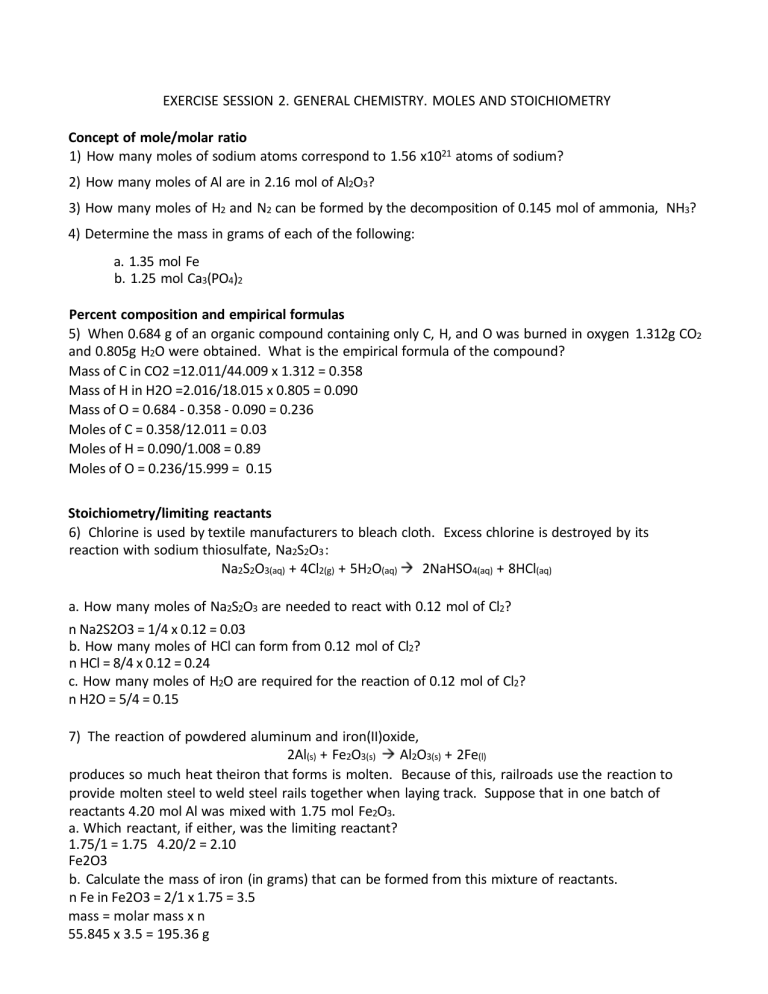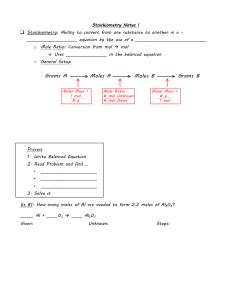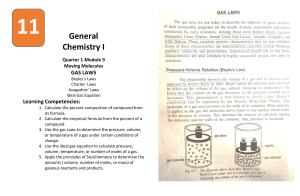
EXERCISE SESSION 2. GENERAL CHEMISTRY. MOLES AND STOICHIOMETRY Concept of mole/molar ratio 1) How many moles of sodium atoms correspond to 1.56 x1021 atoms of sodium? 2) How many moles of Al are in 2.16 mol of Al2O3? 3) How many moles of H2 and N2 can be formed by the decomposition of 0.145 mol of ammonia, NH3? 4) Determine the mass in grams of each of the following: a. 1.35 mol Fe b. 1.25 mol Ca3(PO4)2 Percent composition and empirical formulas 5) When 0.684 g of an organic compound containing only C, H, and O was burned in oxygen 1.312g CO2 and 0.805g H2O were obtained. What is the empirical formula of the compound? Mass of C in CO2 =12.011/44.009 x 1.312 = 0.358 Mass of H in H2O =2.016/18.015 x 0.805 = 0.090 Mass of O = 0.684 - 0.358 - 0.090 = 0.236 Moles of C = 0.358/12.011 = 0.03 Moles of H = 0.090/1.008 = 0.89 Moles of O = 0.236/15.999 = 0.15 Stoichiometry/limiting reactants 6) Chlorine is used by textile manufacturers to bleach cloth. Excess chlorine is destroyed by its reaction with sodium thiosulfate, Na2S2O3 : Na2S2O3(aq) + 4Cl2(g) + 5H2O(aq) 2NaHSO4(aq) + 8HCl(aq) a. How many moles of Na2S2O3 are needed to react with 0.12 mol of Cl2? n Na2S2O3 = 1/4 x 0.12 = 0.03 b. How many moles of HCl can form from 0.12 mol of Cl2? n HCl = 8/4 x 0.12 = 0.24 c. How many moles of H2O are required for the reaction of 0.12 mol of Cl2? n H2O = 5/4 = 0.15 7) The reaction of powdered aluminum and iron(II)oxide, 2Al(s) + Fe2O3(s) Al2O3(s) + 2Fe(l) produces so much heat theiron that forms is molten. Because of this, railroads use the reaction to provide molten steel to weld steel rails together when laying track. Suppose that in one batch of reactants 4.20 mol Al was mixed with 1.75 mol Fe2O3. a. Which reactant, if either, was the limiting reactant? 1.75/1 = 1.75 4.20/2 = 2.10 Fe2O3 b. Calculate the mass of iron (in grams) that can be formed from this mixture of reactants. n Fe in Fe2O3 = 2/1 x 1.75 = 3.5 mass = molar mass x n 55.845 x 3.5 = 195.36 g




